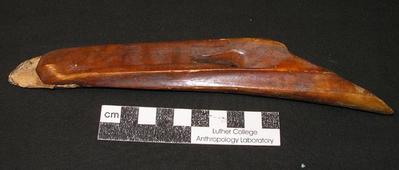E0193: Inuit- Harpoon Point, Toggling
Ethnographic
Identifier:
E0193Classification Category:
4:Tools & Equipment for Materials ➞ Fishing & Trapping T&EMarks/Labels:
Tag: "Scalpel"Materials:
animal ➔ ivoryanimal ➔ bone
Dimensions:
23 cm L4.5 cm W
Provenance of Object:
This object was held in the museum that Luther College started in 1877. This museum eventually grew into the Vesterheim Norwegian-American Museum, and following this, non-Norwegian American ethnographic objects were returned to Luther and accessioned into the college’s Anthropology Collection. Without additional documentation, was likely obtained by the Luther College Museum (later the Norwegian-American Museum) between the late 19th century and early 20th century.Use/Function:
"The harpoon was an invaluable weapon to hunt animals such as seals. Harpoons were designed to pivot sideways upon entering the prey, holding onto the animal while it was pulled towards the hunter. The size of the harpoon head varied depending on what was being hunted. While hunting from a kayak the harpoon head would often be larger than if they were hunting from the ice."- EXH 2015.03 All The Small Things"A typical Eskimo harpoon might have a bone or ivory head. To construct this type, a socket was made in the end of the shaft. The point might also have a tip fitted into a slot, sometimes this tip was provided with it's own line." -page 11, Indian and Eskimo Artifacts of North America

